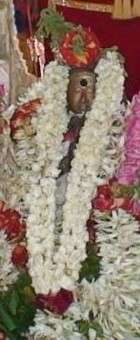Sakkiya Nayanar
Sakkiya Nayanar (c. 7th century CE; known colloquially as Chakkiya Nayanar, Sakkiya, Chakkiya, Sakkiyar, Chakkiyar, and Sakkiyanar) was a Nayanar saint, venerated in the Shaiva sect of Hinduism. He is generally counted as the thirty-fourth in the list of 63 Nayanars. He was a crypto-Hindu posing as a Buddhist, practicing Shaivam in secrecy.[1] He was reported to have worshipped Lord Shiva, his patron god, by hurling stones at his iconography.
Sakkiya Nayanar | |
|---|---|
 | |
| Personal | |
| Born | 7th Century CE Tirucchangamangai |
| Religion | Hinduism |
| Philosophy | Shaivism, Bhakti |
| Honors | Nayanar saint |
Hagiographical account
The life of Sakkiya Nayanar is described in the Periya Puranam by Sekkizhar (12th century), which is a hagiography of the 63 Nayanars.[2] Sakkiya is one of the six Nayanars from the region of Tondai Nadu and lived around the time the Pallava dynasty ruled the area.[3] He is considered a historical figure from the 6th century CE, pre-dating Appar Tirunavukkarasar and Sambandar, both dating from the 7th century CE.[2]
Sakkiya Nayanar was born in the rural village of Tiru Changa Mangai, modern-day Sangaramangai, Nagapattinam District, Tamil Nadu, India. The village at the time was dominated by Tamil Buddhists, followers and contemporaries of the Pallava prince Bodhidharma. Religious tensions were strife during this period, with attacks on Hindus being a regular occurrence. Sakkiya and his family were agricultural land owners from a Hindu Vellalar background, albeit they did become assimilated for their own safety and started posing as Buddhists. In keeping in line with the rest of the Buddhist populace as well as being legitimately interested in spirituality, he went to Kanchipuram and studied at a monastery, eventually becoming a Buddhist monk (Bhikshu). Sakkiya was well-versed in Buddhist theology and philosophy. This is also the origination of his name Sakkiya, a Tamil derivation of Shakya, the name of the clan of the Buddha belonged to. However, Buddhism did not relinquish his thirst for knowledge and enlightenment. So, he embraced Shaivism, however, he did not give up the garb of a Buddhist monk and continued to dress in saffron garments as he was convinced that external appearances did not matter for self-realization. Sakkiya then realised that Shaivism was the true path to salvation and became a devotee of the god Shiva, eventually accepting Shaivism. He realised that the Shaiva philosophy of "the deed, doer, its effect and the controller of the effect" was the most accurate and Shiva was the Truth he was seeking.[2][4]
Sakkiya commenced the worship of the Lingam, Shiva's aniconic symbol. One day, he unconsciously threw a stone at the lingam with great devotion. The next day, Sakkiya felt that it was Shiva's divine wish that he worship Shiva by throwing a stone a day at the lingam as an offering. Sakkiya realized that God will accept any offering which is offered to him with great devotion. Sakkiya would not have food without throwing a stone at the lingam daily. Once, Sakkiya forgot his daily stone worship and was about to partake food. However, he remembered his daily duty and unmindful of hunger, rushed to the temple and threw a pebble at the lingam. Pleased, Shiva appeared before him, blessed him and took him to Kailash, the god's eternal abode.[2][4]
Remembrance
One of the most prominent Nayanars, Appar Tirunavukkarasar (7th century) alludes Sakkiya in a hymn to Shiva where deeds of various saints are recalled. The hymn says how Shiva made Sakkiya worship Him by throwing a stone before having his kanji (porridge) and abandon the eating of rice. Shiva also granted Sakkiya to do service as a Shaivite [5]
Sakkiya Nayanar is depicted with a top-knot or flowing matted hair and with folded hands (see Anjali mudra). A holy day in his honour is observed on the twenty-sixth day of the Tamil month of Margazhi, generally coincides with 10 January.[2] The moon enters the Pūrva Ashādhā nakshatra (lunar mansion) on this day. He receives collective worship as part of the 63 Nayanars. Their icons and brief accounts of his deeds are found in many Shiva temples in Tamil Nadu. Their images are taken out in procession in festivals.[1]
References
- Roshen Dalal (2011). Hinduism: An Alphabetical Guide. Penguin Books India. p. 281. ISBN 978-0-14-341421-6.
- Vidya Dehejia (1988). Slaves of the Lord: The Path of the Tamil Saints. Munshiram Manoharlal. pp. 155–6. ISBN 978-81-215-0044-9.
- P. V. Jagadisa Ayyar (1982). South Indian Shrines: Illustrated. Asian Educational Services. p. 85. ISBN 978-81-206-0151-2.
- Swami Sivananda (1999). Sixty-three Nayanar Saints (4 ed.). Sivanandanagar: The Divine Life Society.
- Swami Parmeshwaranand (2004). Encyclopaedia of the Śaivism. Sarup & Sons. p. 51. ISBN 978-81-7625-427-4.